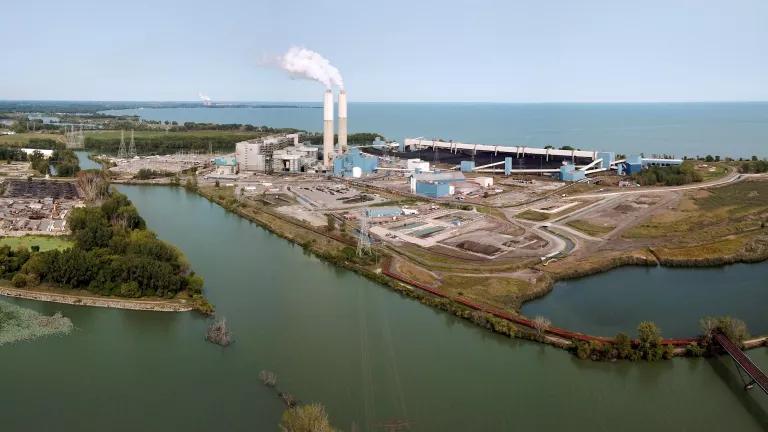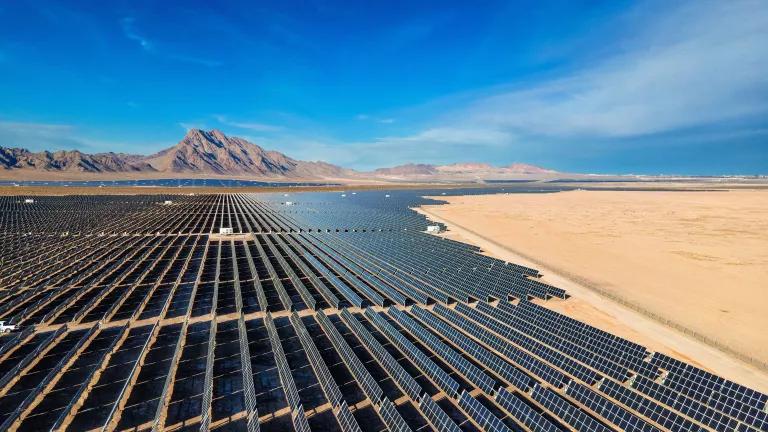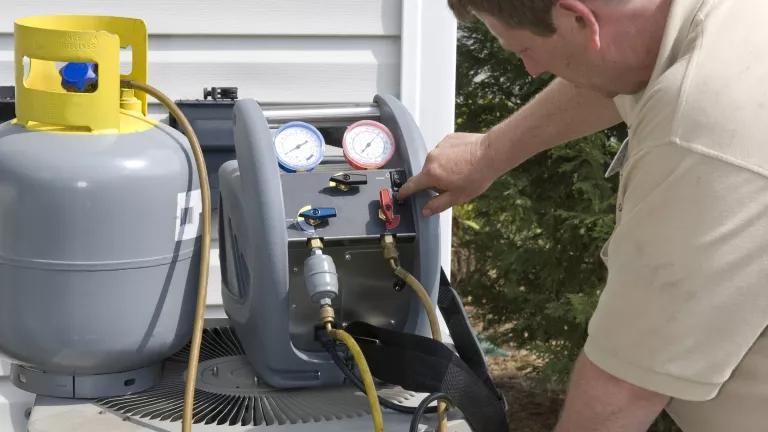EPA’s Power Plant Standards: Just the Facts
The EPA's power plant standards will ensure that utilities pursue the clean energy investments that are best for Americans’ wallets, health, and our climate.
The U.S. Environmental Protection Agency (EPA) is set to finalize standards to limit carbon pollution from power plants this month. The original proposal released in May 2023 included emission limits on existing coal power plants, existing gas-fired power plants, and new gas-fired power plants. At the end of February, the EPA announced a new plan: to finalize standards for existing coal plants and new gas plants now, and to repropose standards for existing gas plants that would cover more of the existing gas fleet and be developed in tandem with other standards to curb other toxic pollutants from these plants.
So, given this tack in direction, where do we stand on cleaning up this major source of pollution?
EPA’s Carbon Pollution Standards Complement and Bolster the Inflation Reduction Act
Modeling—by NRDC, the Electric Power Research Institute (EPRI), and the EPA—all find that these proposed standards can be met at minimal costs to utilities and their customers. This is because these standards largely build on the market-driven changes already underway in the power sector due to falling costs for clean energy and the federal incentives in the Inflation Reduction Act. These standards complement economic forces to deliver important reductions in carbon emissions. NRDC analysis finds that these rules, on top of the prior trends and IRA funding, could result in an 80 percent reduction in power plant carbon emissions in 2035 from the peak three decades ago. This is a historic change that would have been inconceivable just a few years ago.

And these standards will drive greater climate benefits across the U.S. economy, further cleaning up industry and transportation as we electrify our cars and industries. Overall, the Inflation Reduction Act and EPA’s rules for methane, cars, trucks and the upcoming power plant rules, will put the United States on pace to cut overall economy-wide emissions by 42 percent by 2030 according to NRDC analysis. Not enough to meet the country’s climate goals, but much closer to where we need to head than we were just two years ago, before the finalization of these rules or passage of the IRA.

Why the EPA Power Plant Rules Are So Important
The EPA’s standards build upon the already expected changes in the power sector. They are a crucial backstop to ensure the power sector delivers the carbon reductions that are possible cost-effectively. Without these standards the steep reductions in power sector carbon pollution that are expected are not guaranteed. The Inflation Reduction Act is primarily incentive-based. If there is slower uptake than models project is economic—say for political or specific corporate financial reasons—emissions will not be reduced as much as predicted. The EPA standards will ensure that utilities pursue the clean energy investments that are best for Americans’ wallets, health, and our climate. In this way, the EPA’s standards will work together with the congressionally passed IRA incentives to ensure that we get a cleaner grid and consumers get cheaper, greener power sources.
Modeling by diverse organizations has consistently showed with the IRA’s incentives these rules can be met at little or no cost to consumers, with studies finding these rules could deliver overall economic savings, and at most would cost $11 billion over 15 years.
And this does not include the public health, climate, and other social benefits from reducing climate-damaging and health-harming pollution due to these rules. These rules will deliver significant health benefits, cutting down on asthma attacks and heart disease—and that will provide significant economic benefit to the nation, as well. The IRA is also projected to have the biggest impact over the next decade, but then as incentives phase down, emissions are expected to plateau. These standards will ensure we stay on the path to long-term grid decarbonization, which is key to achieving a net-zero economy by 2050.
The EPA Should Strengthen Standards for Existing Coal and New Gas Plants
EPA can make simple but consequential changes to its proposed standards for existing coal and new gas that will result in important emissions reduction benefits. NRDC is urging the administration to make some crucial changes to the rules for new gas and coal that will really deliver significant emissions reductions. These include:
- The EPA’s standards set emissions limits for coal plants based on carbon capture and sequestration. For those plant owners that choose not to install carbon capture and sequestration, the EPA proposed a deadline of 2040 for the plants to retire. Our modeling finds that moving this deadline to 2038 would deliver an additional 200 million short tons of carbon reductions in just that year alone.
- Lower the capacity factor for large new baseload gas plants subject to the most stringent standards from 50 percent to 40 percent, which would require more new gas plants to control their GHG emissions. Based on EPA modeling, this change could prevent up to 10.6 million short tons of carbon pollution a year, equivalent to the annual pollution from 2.5 million cars on the road.
- Base the intermediate level standard on combined cycle plants instead of simple cycle ones, to ensure new “load-following” plants use the most efficient technology.
- Lower the capacity factor limit for the “peaker” subcategory to no higher than 15 percent, down from 20 percent in the proposal.
Each of these changes is simple and straightforward and will ensure that the EPA standards work as they are meant to – preventing backsliding by existing plants and the building of unnecessary and uncontrolled new gas plants.
Addressing Carbon from Existing Gas Is Critical to Achieving Strong Standards
Last year the EPA estimated that the existing gas component of the proposed standards would deliver just 20 percent of the overall carbon reductions, with 80 percent of the reductions coming from the existing coal and new gas standards. That’s primarily because the existing gas portion of the EPA’s original proposal covered only the largest, most heavily run existing gas facilities (those units more than 300 megawatts and running more than half the time). Based on NRDC’s calculations, this covered just a little more than 30 percent of gas combined cycle capacity. In comments to the agency, NRDC and partners recommended the EPA expand coverage by reducing the size and capacity factor thresholds. This would help limit any “leakage” as power plant owners would shift generation to stay under the cap but run other plants more often.
The EPA is now planning a reproposal intended to cover carbon emissions from all of the existing gas fleet, combined with rules to reduce other dangerous pollutants. The reproposal can make standards for the existing gas fleet much more impactful. Gas plants were responsible for 49 percent of all power sector carbon pollution in 2023, up from just 13 percent 20 years ago. And under “business-as-usual,” existing gas plants are projected to make up 70 percent of all power sector carbon emissions by 2040 according to NRDC modeling.
As coal plants continue to retire due to economics and age, existing gas plants fill the gap. It is essential to cover this growing source of carbon pollution; without addressing existing gas, any rule would fail to effectively regulate and reduce the power sector’s climate footprint.
The EPA Must Move Forward with a Multi-Pollutant Approach that Addresses All Power Plant Types
While developing this new proposal, it’s critically important for the EPA to address all forms of dangerous air pollution from existing gas plants. As we noted in comments on the proposal, EPA modeling showed the potential for emission increases of co-pollutants like NOx at plants that may run more after installing GHG controls. We recommended then that EPA strengthen its permitting policies and regulations under its existing Clean Air Act authority to ensure that neighboring communities were protected from such increases. Under the New Source Review (NSR) program, the EPA or its delegated state permitting authority must review proposed modifications at existing sources to ensure that potential emission increases are sufficiently controlled. After decades of deregulatory weakening during the G.W. Bush and Trump administrations, there are numerous loopholes that the EPA can and should now close to ensure that NSR is implemented as Congress intended.
We will continue to advocate for such measures, as well as common sense steps like updating NOx and hazardous air pollutant standards for combustion turbines under Clean Air Act sections 111 and 112, respectively. The EPA must follow through quickly on its stated plans to address both the carbon and other pollution from these plants. The agency is already soliciting ideas for this next round of rulemaking and will be holding a forum for stakeholders on May 17. We’ll be there urging the agency to propose strong, comprehensive standards for both carbon and other pollutants.




